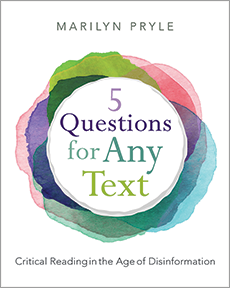Teaching Our Students How to Be Text-Savvy
 In her MiddleWeb article 5 Questions to Help Kids Become Critical Readers, ELA teacher, author, NBCT and Pennsylvania TOY Marilyn Pryle describes how standardized testing has slowly erased the “wonder of reading and writing, the curiosity and agency…that children tether to their sense of self-worth.”
In her MiddleWeb article 5 Questions to Help Kids Become Critical Readers, ELA teacher, author, NBCT and Pennsylvania TOY Marilyn Pryle describes how standardized testing has slowly erased the “wonder of reading and writing, the curiosity and agency…that children tether to their sense of self-worth.”
After growing up in a system that has cobbled literacy’s power “into skill-sized, testable bits and ‘right answers’,” few students “know how to think critically or have the stamina to do so,” Pryle says.
Her solution? Help today’s students become critical readers…”to look beyond a text itself – any text, in any form – and see the influences around it, the voices and sponsors, the craft and rhetoric, the intent and message.”
And how do teachers do that? The five questions Pryle summarized in her March post point the way. In this MiddleWeb series, she goes on to explore each question in some depth.
The complete series includes these articles: Introduction: 5 Questions to Help Kids Become Critical Readers | Question #1: What Am I Reading? | Question #2: What Is the Text Showing? | Question #3: What Is the Text Hiding? | Question #4: How Am I Reacting? | Question #5: How Does It Work? To see summaries of the complete series in one place, go here.
Question 1: What Am I Reading?
By Marilyn Pryle
Two years ago I knew my students were participating well in class, completing their reading (for the most part) and enjoying the curriculum (for the most part).
For the majority of them, their grades were solid. They were performing well on assessments. But I wondered: Were they reading critically IRL, outside of school? Did they look beyond whatever text was in their hands – whether a book, video, post, article, or show – and not simply accept it at face value, but think critically about it?
This question led me to another question: What do critical consumers of text, in any form, actually do? What happens in our brains? And can I teach it to students? From there, I developed the 5 Questions.
The 5 Questions are thoughts that – consciously or unconsciously – experienced, critical readers think about with any new text they encounter. Even though I will present them in a numbered way in this series, they need not be experienced linearly; our brains are constantly circling around each question as needed. But the investigation is always ongoing.
The first question, What Am I Reading?, may seem like an obvious, unnecessary question. One is either holding a book, opening a newspaper, turning on a television, or clicking on a podcast. Even with physical text on paper, it seems clear: Novels are clearly novels, articles look like articles, dramas can’t be anything but dramas. Sure, the discussion should be had with students about genres that go beyond the basic division of fiction and nonfiction, but for the most part, in the course of a day, we all know what we’re reading, right?
Not necessarily, especially for students. Young people experience a stream of information in a variety of media every day of their lives. This information comes in all forms – text, video, audio, images, and emojis – and all genres, ranging from daily news to fictional stories to historical renderings to personal updates. And it mostly comes from digital sources: their phones, their tablets, their school-issued computers. During school hours there may be some books, paper handouts, or a video on a large screen.
But these media represent an increasingly shrinking part of the overall media they consume in a day. Most adults have experienced the newer forms of the information stream piece by piece over the years, as each was developed and layered on to the existing system. For students, it’s just one giant, mixed torrent.
What’s more, the swirls of motives within this torrent have become increasingly, deliberately, muddied. The intentions behind texts have become progressively more difficult to discern on a surface level. A fun, seemingly innocent video may also be selling a service or product; a traditional-looking news article may actually be a piece of propaganda; a commercial that seems to be for everyone may contain trigger words that are meant to motivate a certain group.
With every new text, a reader must ask, “What is this?” if they are to actively and critically engage in a full understanding of the text. In school we often identify genres for our students, because we feel that our mission as teachers is to give them as much information as possible. We might say something like, “Take a look at this poem,” or “Here’s a documentary on the Harlem Renaissance.”
But we must start to pass this responsibility on to the students themselves if we want them to be critical readers after they leave our classrooms. Moreover, we have to encourage students to look not only at genre, but at authors’ intentions behind their choices of genre. Students must develop the intellectual habit of questioning a text at these levels.
The alternative is assumption – assuming something is fact when it’s fiction, fiction when it’s fact, neutral when it’s biased, innocent when it’s calculating. Going along with surface-level appearances teaches minds to accept what they see without inquiry or doubt. And thus, this is where we begin, questioning the surface itself: What am I reading?
Using Reading Responses with This Question
In my classroom I use a method I call Reading Responses to have students authentically, responsibly, and habitually respond to texts. I have written about it often here at MiddleWeb; please see this article from last year for a discussion about the method. (Additionally, please see my book Reading with Presence for an in-depth exploration of all the possibilities Reading Responses offer.)
In short, a Reading Response consists of an original thought, a metacognitive category, a cited quote, and five sentences. In my class we do at least one a day, thus making it a constant, low-stakes writing practice.
To implement Question #1, I give students Reading Response categories such as:
- Name the Genre
- Identify the Audience
- Who Tells the Story?
- Clarify Cultural Values
- See the Source
Each of these categories comes with some prompting questions to help students explore their thinking on the topic, and students can always choose the category they want to respond in. Notice how each category topic listed here relates to the core idea in Question #1 – What am I reading? When we investigate genre, intended audience, the voice of the author, the cultural values surrounding the text, and the possible source behind the author or message, we get a fuller picture of what we are actually reading or viewing. Let’s look at a student’s example for “Name the Genre.” First, here is the category prompt:
Name the Genre
What is the genre of this work? How do you know? What elements make the genre identifiable? Why did the author choose this particular genre to communicate the content?
Here is a student’s Reading Response:
Name the Genre for “The Fisherman and the Jinnee,” by Gineva
In this story the genre of folk tale fits it a lot better than others would. The text says, “The king raised his eyes and saw in the tree an enormous serpent spitting its venom down the trunk” (p. 93). In this moment the king realizes his mistake and learns a painful lesson. In any other genre, be it sci-fi, fantasy, epic, or realistic fiction the message of the whole story wouldn’t come across as much. This is because in folk tales the purpose and focus of the story is the lesson, while in other genres it would be the grief of the king, taking a deep dive into his emotions and coping at this point in the story. No matter what other genres it would be, it would be focused on the character and the plot, whereas folk tales specifically teach a lesson.
Here, Gineva does an excellent job differentiating folk tales from other genres. Think about that simple thought for a moment – if your students are like mine, they call everything a “novel.” For Gineva to distinguish folk tales from sci-fi, fantasy, epics, and realistic fiction is a victorious moment in itself! But she goes beyond that. She identifies the purpose of folk tales and applies that purpose to her quote.
When I talked with Gineva about this response (I have a brief conference with each student about their RR each day), I asked her who the intended audience is and what the purpose and effect of that are. We discussed how folk tales are meant for children, so that a culture’s values can be instilled in them. I asked her what popular folk tales exist in our own society, and what the lessons are.
* * *
When students get in the habit of asking themselves “What Am I Reading?” they train their minds to critically approach all information they encounter both inside and outside of school. Looking through the lenses of genre, intended audience, and the author or supplier of the content, will help them pull back the curtain on texts and not just accept information as impenetrable truth to be unquestioningly taken in.
As English teachers, we must equip students with the tools that will give them more agency, clarity, and voice as they move into adulthood.
Find all the Five Questions articles here.

Pre-order her new Heinemann book, Critical Reading in the Age of Disinformation: 5 Questions for Any Text, coming in November 2024. Learn more about her work at her website and read her many articles for MiddleWeb here.
This article is adapted in part from material in Critical Reading in the Age of Disinformation ©2024 Heinemann Publishers.




































